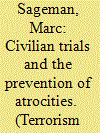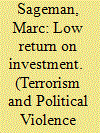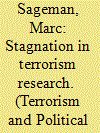| Srl | Item |
| 1 |
ID:
102518


|
|
|
| 2 |
ID:
080882


|
|
|
|
|
| Publication |
2008.
|
| Summary/Abstract |
This article highlights initial findings from the authors' Global Transnational Terrorism (GTT) Project, which began in August 2006. The case study draws on the database work for Southeast Asia and charts the rise of a militant minority within Jemaah Islamiyah, which was directly responsible for a series of attacks from 2000-2005. The important but restricted role of radical madrassahs and the importance of kinship emerge clearly from the study. On a more theoretical plane, the article shows how leadership "niches" opened up by unplanned events create contingent opportunities that lead to new developments.
|
|
|
|
|
|
|
|
|
|
|
|
|
|
|
|
| 3 |
ID:
095602


|
|
|
| 4 |
ID:
178917


|
|
|
|
|
| Summary/Abstract |
A robust empirical finding is that global neojihadi terrorism is extremely rare in Western countries compared to other kinds of violence. Its base rate in the West is about 3 new global neojihadis per 100 million people per year. Bayesian conditional probability shows that this extremely low base rate ensures that any attempt to detect a potential global neojihadi on the basis of imperfectly specific indicators (conditions) will generate a large number of false positives. This finding has practical implications for a preventive counterterrorism strategy based on detection of potential global neojihadi terrorists using these indicators derived from counterterrorism research. Detection instruments based on them produce many false positives, namely overt sympathizers, who, absent state agents’ entrapment, never cross the line to political crime and violence. The state pursuit of false positives not only diverts scarce resources from targeting true threats but also results in unfair harassment, persecution, and even prosecution of these false positives. This paper suggests that, as scholars whose work helps craft these indicators, we have the moral duty to teach state practitioners about this relatively neglected implication of the extremely low base rate of global neojihadi terrorism.
|
|
|
|
|
|
|
|
|
|
|
|
|
|
|
|
| 5 |
ID:
081960


|
|
|
|
|
| Publication |
Philadelphia, University of Pennsylvania Press, 2008.
|
| Description |
viii, 200p.
|
| Standard Number |
9780812240658
|
|
|
|
|
|
|
|
|
|
|
|
Copies: C:1/I:0,R:0,Q:0
Circulation
| Accession# | Call# | Current Location | Status | Policy | Location |
| 053592 | 363.325/SAG 053592 | Main | On Shelf | General | |
|
|
|
|
| 6 |
ID:
133540


|
|
|
|
|
| Publication |
2014.
|
| Summary/Abstract |
First, I would like to thank David Rapoport for making this exchange possible. It is an important aspect of scholarly debate that has been missing from terrorism research. I also wish to thank the authors of the comments on my article on the stagnation on some part of terrorism research. I appreciate their kind words about my past work. Such praise coming from colleagues I truly esteem, and from whom I've learned so much, means a lot to me. However, I would also like to correct their impression about my mood. Far from being gloomy or pessimistic, I took to survey the area of terrorism research in order to see where we are and what we should do as a collegium. What should we do to improve terrorism research? Let me address each of the commentators in the order I read them.
|
|
|
|
|
|
|
|
|
|
|
|
|
|
|
|
| 7 |
ID:
178945


|
|
|
|
|
| Summary/Abstract |
Altier, Boyle, and Horgan claim a 64.6 percent terrorist recidivism rate. However, the unrepresentativeness of their sample, a confusion between the notions of a recidivism base rate and the percentage of recidivists in a sample, and a questionable concept of a global terrorist population undermine their claim.
|
|
|
|
|
|
|
|
|
|
|
|
|
|
|
|
| 8 |
ID:
133534


|
|
|
|
|
| Publication |
2014.
|
| Summary/Abstract |
Despite over a decade of government funding and thousands of newcomers to the field of terrorist research, we are no closer to answering the simple question of "What leads a person to turn to political violence?" The state of stagnation with respect to this issue is partly due to the government strategy of funding research without sharing the necessary primary source information with academia, which has created an unbridgeable gap between academia and the intelligence community. This has led to an explosion of speculations with little empirical grounding in academia, which has the methodological skills but lacks data for a major breakthrough. Most of the advances in the field have come from historical archival research and analysis of a few field interviews. Nor has the intelligence community been able to achieve any breakthrough because of the structure and dynamic of this community and its lack of methodological rigor. This prevents creative analysis of terrorism protected from political concerns. The solution to this stagnation is to make non-sensitive data available to academia and to structure more effective discourse between the academic and intelligence communities in order to benefit from the complementary strengths in these two communities.
|
|
|
|
|
|
|
|
|
|
|
|
|
|
|
|
| 9 |
ID:
067611


|
|
|
|
|
| Publication |
Philadelphia, University of Pennsylvania Press, 2004.
|
| Description |
ix, 220p.
|
| Standard Number |
0812238087
|
|
|
|
|
|
|
|
|
|
|
|
Copies: C:1/I:0,R:0,Q:0
Circulation
| Accession# | Call# | Current Location | Status | Policy | Location |
| 051188 | 303.625/SAG 051188 | Main | On Shelf | General | |
|
|
|
|